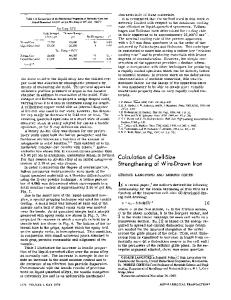Method for Evaluating Potential Maximum Shear Strain for a Fine Metal Wire in Torsion Testing
- PDF / 1,407,359 Bytes
- 11 Pages / 595.276 x 790.866 pts Page_size
- 36 Downloads / 333 Views
RESEARCH PAPER
Method for Evaluating Potential Maximum Shear Strain for a Fine Metal Wire in Torsion Testing S. Gondo 1
&
H. Akamine 2 & R. Mitsui 2 & S. Kajino 1
&
M. Asakawa 2 & K. Takemoto 3 & K. Tashima 3 & S. Suzuki 2,4,5
Received: 15 July 2019 / Accepted: 11 August 2020 # The Author(s) 2020
Abstract The torsion number of drawn fine high carbon steel wires was measured through torsion testing. The angles between the scratches on the tested wire surface and its longitudinal axis were measured. The shear strain calculated from torsion number γt, shear strain at fractured point γf, and plastic shear strain γpc were evaluated. The following results were obtained. First, the shear strain distribution homogenized; further, torsion number per unit length N, γt, and γpc increased when decreasing the difference between γf and γpc where γpc subtracted from γf (=Δγfpc) > 0. Second, the external factors caused non-uniform shear strain distribution and reduction from the potential maximum shear strain, even for the wire that was hardly affected by the internal factors. The difference of shear strain nonuniformity caused a variation in reduction from the potential maximum shear strain. The internal factors included non-uniform microstructure and existence of inclusions and voids. The external factors were caused by the testing machine and setting of the sample. The potential maximum shear strain was obtained when the effects of internal and external factors were inhibited. Finally, two evaluation methods of the potential maximum shear strain were suggested. One method identifies a sample with a small Δγfpc, and a large γpc where Δγfpc > 0. This sample can be regarded as having the closest strain to the potential maximum shear strain. The other method determines γpc when Δγfpc is closest to 0. This value can be interpreted as plastic strain of the potential maximum shear strain. Keywords Fine metal wire . Torsion testing . Torsion number . Shear strain
Abbreviations ISO International Organization for Standardization JIS Japanese Industrial Standards SEM Scanning Electron Microscope * S. Gondo [email protected] 1
Advanced Manufacturing Research Institute, Department of Electronics and Manufacturing, National Institute of Advanced Industrial Science and Technology (AIST), 1-2-1 Namiki, Tsukuba, Ibaraki 305-8564, Japan
2
Department of Applied Mechanics and Aerospace Engineering, Faculty of Science and Engineering, Waseda University, 3-4-1 Okubo, Shinjuku, Tokyo 169-8555, Japan
3
Factory Automation Electronics Inc., 1-6-14 Higashi-nakajima, Higashi-yodogawa, Osaka, Osaka 533-0033, Japan
4
Department of Materials Science, Faculty of Science and Engineering, Waseda University, 3-4-1 Okubo, Shinjuku, Tokyo 169-8555, Japan
5
Kagami Memorial Research Institute for Materials Science and Technology, Waseda University, 2-8-26 Nishi-waseda, Shinjuku, Tokyo 169-0051, Japan
Nomenclature a Coefficient of a function: γt = aγpi d Diameter of the wire [mm] h Distance between the intersections; intersection A of the stra
Data Loading...











